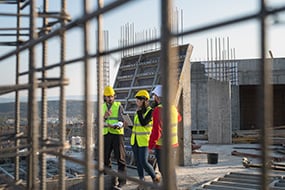On Oct. 1, 2019, prompt payment and adjudication under the Construction Act came into force in Ontario, which became the first jurisdiction with legislation that combined prompt payment and adjudication in addition to traditional lien legislation.
Since then, other jurisdictions have moved to adopt similar legislation — including the federal government for federal infrastructure projects — and the Federal Prompt Payment for Construction Work Act received royal assent in June 2019.
Construction lawyers say they have seen an increase in adjudication and compliance with prompt payments, as well as in virtual hearings — and the benefits of them all.
“Adjudication is a swift and pragmatic dispute resolution mechanism,” says Sharon Vogel of Singleton Urquhart Reynolds Vogel LLP in Toronto. It provides for an interim binding decision to be made by an adjudicator, who is trained and has expertise in construction, with the expectation that they make a binding decision within a 39- to 46-day period, she says. An adjudication must begin prior to completion of the contract or subcontract unless the parties agree otherwise.
Adjudication was intended to deal largely with payment disputes, says Vogel. “For the largest types of disputes . . . involving delays, disruption and more complicated claims, those disputes are often addressed through arbitration.”
Many adjudicators are former construction law lawyers and “are familiar with the nature of commercial transactions and the construction law that applies to it,” says Ken Eccleston, a partner at Miller Thomson LLP in Toronto.
Find the best construction lawyers in Ontario, Canada in this link.
Parties to adjudication will have a less costly and more streamlined process, he says. “An adjudicator doesn’t have to follow the rules of evidence to the letter. . . . There’s been a significant movement to arbitration clauses in contracts.”
Arbitration clauses are enforceable, while trials are highly structured and “often result in unsatisfactory results, win or lose. It’s a frustrating thing to go into that process.”
Howard Krupat, a partner at DLA Piper (Canada) LLP’s Toronto office, sees a positive change in the construction landscape in Ontario as a result of increased adjudication.
“I would anticipate that construction disputes will get resolved earlier in projects, and there will be binding resolutions parties will be forced to abide by, rather than waiting for disputes to aggregate into a large litigation or arbitration project well after the project is complete.”
Adjudication should reduce the volume of large, complex disputes, he says.
Litigation may still be a preferred option when parties want transparency, for example, as arbitration may be confidential, Vogel says. Where public entities are involved, they may prefer to have litigation so that the dispute is heard in a public courtroom and that the decision that is rendered is publicly available.
Other disincentives to arbitration include the implications of adjudication-related debarment provisions in the adjudication document, says Vogel. If a contractor or subcontractor commences a litigation — if they haven’t been paid, for example — “then the fact that they’ve commenced that adjudication might allow a contracting authority, an owner, to debar or prevent them from bidding on future work.
“That can have a chilling effect” in utilizing adjudication, she says.
Krupat is seeing an emphasis on compliance with the prompt payment legislation. Both contractors and owners have made a significant effort to structure contracts to comply with the renewed act in Ontario, he says, and although many projects are not governed by the prompt payment regime because they fall under the old provisions of the act, there is a set of transition rules for projects in which the contract was entered into or put out for procurement prior to Oct. 1, 2019.
However, Krupat says, there are other factors that go into analyzing whether any particular contract or project falls under the old act or under the new act, and “so one of the considerations that parties preparing construction contracts have to take into consideration now is which version of the act they’re under, and to try to ensure that that’s reflected in the agreement.”
Virtual dispute resolution and other trends
Significant strides have been made in resolving disputes using technology and a virtual process, says Krupat. “Effective mediations can be run virtually; it takes significant planning and preparation to ensure that the process runs smoothly, [and] it requires lawyers and tribunals who buy into the process so that clients also have confidence that they’re getting a proper hearing. But I think we’re going to see a great deal of growth in that area.”
During the novel coronavirus pandemic, parties have seen how effective the technology is, he adds.
“One thing we’ve learned from being forced to use technology [is that] it’s possible to facilitate complicated, document-intensive dispute proceedings that we’re accustomed to see on construction projects in a virtual environment. As a result, I think that we’re going to see the growth of virtual proceedings, regardless of how long this pandemic continues.”
“On all fronts, we’ve seen that, over the past few months, parties have been able to accomplish what the courts and arbitrators and mediators have been trying to do for the past two decades,” says Vogel. “It has been very difficult to do things virtually in [the] past, but they’ve adapted. Some parties have said they wouldn’t go back to in-person mediation, the virtual had been so successful.”
Cost, time and scheduling difficulty are all reduced through virtual dispute resolutions, she says. “You lose the face-to-face ability, but it’s amazing how much can be accomplished in those virtual settings, at a much lower cost.”
Eccleston concurs. “It’s the way of the future, whether we get a COVID vaccine or not.”
His first virtual dispute resolution, in late June and early July, reduced what would have taken nine or 10 days to six days, he says. On the sixth and last day of the session, there were two witnesses left and proceedings were finished by 4 p.m.
In a courtroom environment, one “can never predict the length of time it will take to examine a witness and have them cross-
examined,” Eccleston says. In virtual hearings, witnesses can testify from their home or office, and arbitration legal centres such as Arbitration Place can place them in “a virtual room” in which lawyers can call them.
Ecclestone says he found that the evidence flowed better. In a courtroom environment, there are a lot of stops and starts, he says, but, in his virtual hearing, the parties had agreed on the documents to be reviewed, went to the links and “all the tabs were in order.” For multiple parties in different locations, the process was “very efficient.”
“In all of that time, we didn’t have one technical glitch, and it flowed so well. I worked from the comfort of my home,” he says. “At break, I made a pot of coffee. I had my assistant helping; I’d send her an email, and she’d log on [to the virtual room]. It was enormously efficient. I can’t sing the praises more.”
Another trend, says Vogel, is in the growth of dispute resolution boards, which are already in wide use in the United States and are being used on large projects in Canada. The dispute resolution board is created at the outset of a project, with up to three members chosen by the parties who will remain in place over the life of the project. Their role is advisory, giving guidance to the parties, and it may include an adjudicative function, making advisory or even binding decisions.
Also on the rise are new contract models such as alliance contracts, she says, which are intended to be more collaborative in nature and can include provisions to minimize disputes on projects.
Warding off disputes at the pass
“Communications among parties on a construction project are a primary factor in driving whether there are disputes,” says Krupat.
“Whether communications are effective and timely is a good way to avoid construction disputes.”
Another important strategy, he says, is to ensure there is an organized, comprehensive documentary record on a project, including updated schedules, properly maintained timesheets and all parties maintaining complete sets of their own records.
Vogel advocates having “a clear, contractual allocation of risk when entering into a contract,” which should be appropriate and fair.
Practising dispute avoidance over the course of the project and mitigating issues when they arise is especially important now, she says, when the construction industry is facing unexpected issues arising from COVID-19, such as extraordinary cleaning and disinfecting, social distancing, the meaning of “essential” businesses changing over time and supply chain problems.
“I think we’re going through a time of transition in the construction industry,” Krupat adds, “and that parties are motivated to focus on dispute prevention. We’ve made strides through legislative reform and also through a better understanding of what drives disputes on construction projects, to try to make it possible to avoid disputes and to resolve them early when they do arise.
“Time will tell whether in practice we’ll see a reduction in both the prevalence and size of construction disputes as a result.”





